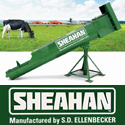 |
 |

|
|
|
North Dakota Ag News Headlines |
 |
Data-Driven Approach to Measuring Ag Sustainability in Large Landscapes
North Dakota Ag Connection - 05/14/2021
Scientists at the United States Department of Agriculture, Agricultural Research Service (USDA-ARS) use large, standardized (big) data to evaluate land management and sustainability in large landscape.
USDA-ARS Range Management Research Unit, Jornada Experimental Range in Las Cruces, N.M., developed an innovative approach to using datasets on vegetation, climate, and land use to evaluate the long-term effects of agricultural practices used in extensive rangelands managed by a collaborative conservation group.
Collaborative conservation groups are organized groups of farmers working together to achieve common agricultural and marketing goals. The conservation strategies used by these groups are presumed to support land health for future generations of ranching communities. "Efforts to measure the efficacy of these strategies at a broad-scale were limited by lack of high-quality scientific data," said Brandon Bestelmeyer, Research Leader at the Range Management Research Unit. "Recently, access to an extensive amount of long-term data from a variety of sources made it possible to compare environmental changes across large rangeland areas."
In the study, scientists used spatial and statistical models to evaluate the effects of coordinated agricultural management and conservation activities used over the last 25 years by one collaborative group, the Malpai Borderlands Group. The Malpai Borderlands Group is a collective effort lead by ranchers who live and work primarily in southeast Arizona and southwest New Mexico. Scientists used information available on ranch ownership alongside data obtained from remote sensing technologies (such as satellites and aircraft) to compare climate, vegetation coverage, and land conversion of rangeland across thousands of square miles surrounding the Malpai Borderlands region. Scientists found that despite its high aridity, the landscape managed by the Malpai Borderlands Group is comparatively productive and healthy.
This approach made it easier to understand the effects of conservation strategies used within the 800,000-acre Malpai landscape. Due to conservation easement agreements, land conversion due to urban developments was limited compared to the surrounding landscapes. This allows Malpai managers to successfully use specific agricultural techniques, such as prescribed fire, to control woody plant encroachment to a much greater extent than in surrounding areas. These insights are essential to help ranchers and managers identify and promote a suite of sustainable management practices.
The methodology developed in this study, based mostly on open access data including the Rangeland Analysis Platform, Cropland Data Layer, and gridMET climate dataset, can be used to evaluate management in other rangelands at broad scales across the United States and to monitor rangeland resilience in the face of climate change.
ARS is the U.S. Department of Agriculture's chief scientific in-house research agency. Daily, ARS focuses on solutions to agricultural problems affecting America. Each dollar invested in agricultural research results in $17 of economic impact.
Other North Dakota Headlines
|
|
 |


|
 |
|
Copyright © 2024 - Farms.com. All Rights Reserved. |
 |
|